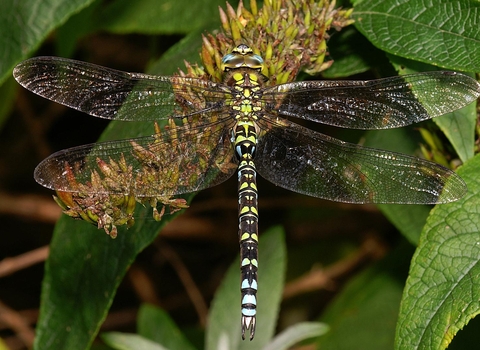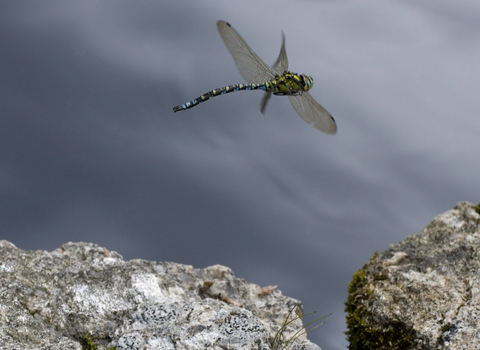
©David Longshaw

©Zsuzsanna Bird
Southern hawker
A common dragonfly of ponds, lakes and canals near woodland, the Southern Hawker can be seen patrolling the water or 'hawking' through woodland rides. A fast-flying species, it will catch its prey mid-air.
Enw gwyddonol
Aeshna cyaneaPryd i'w gweld
June to OctoberGwybodaeth am rywogaethau
Ystadegau
Length: 7cmCommon.
Ynghylch
The Southern hawker is a large hawker dragonfly that is on the wing from the end of June through to October. A common dragonfly of ponds, lakes and canals in the lowlands, particularly near to woodland, it can be seen patrolling a regular patch of water when hunting, or often 'hawking' through woodland rides. Hawkers are the largest and fastest flying dragonflies; they catch their insect-prey mid-air and can hover or fly backwards.Sut i'w hadnabod
The Southern hawker is mostly black in colour. The male has lime green spots all along the body, pale blue bands on the last three segments of the abdomen, blue-green eyes, and large green patches on the thorax. The female is paler, with pale green spots and brownish eyes. The black-and-blue hawkers are a tricky group of dragonflies to identify. The Southern hawker can be recognised by its lime green, rather than blue, spots and the large pale patches on its thorax.Dosbarthiad
Found in England and Wales, but slowly spreading into Scotland.In our area
This species can turn up almost anywhere in the area; it is frequently seen along the Montgomery Canal.
Roeddech chi yn gwybod?
The Southern hawker is a very inquisitive dragonfly: males will often fly towards the observer, hovering nearby to have a closer look.This species can turn up almost anywhere in the area; it is frequently seen along the Montgomery Canal.
